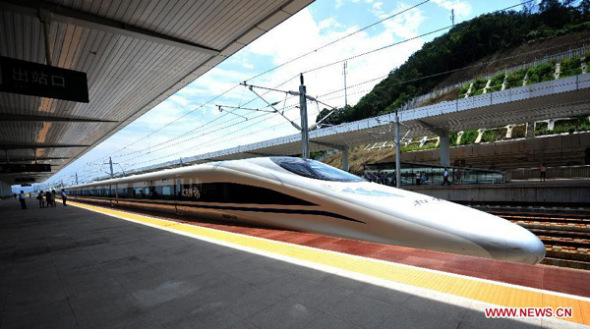

A bullet train traveling between Hangzhou and Nanjing enters Deqing Railway Station in east China's Zhejiang Province, July 1, 2013. The Nanjing-Hangzhou-Ningbo high-speed railway that stretches across east China's Yangtze River Delta was officially put into operation on July 1. The new high-speed railway is expected to boost the region's economy and foster the growth of tourism in the three cities it links (Xinhua/Wang Dingchang)
The Ninghang and Hangyong high-speed railways went into operation on Monday, marking new progress in efforts to energize the regional economy of the Yangtze River Delta in east China.
The Ninghang railway, which links Nanjing and Hangzhou, the capitals of Jiangsu and Zhejiang provinces, respectively, is expected to become a crucial part of the delta's intercity transport system.
With a length of 256 km, the railway will cut travel time between Nanjing and Hangzhou from 140 minutes to 70 minutes.
The Hangyong high-speed railway, which links Hangzhou and Ningbo, a port city in Zhejiang, also went into operation Monday morning, cutting travel time between the two cities to 50 minutes. The Hangyong railway is expected to become an important transportation link in southeast China's coastal areas.
The Yangtze River Delta, which includes Shanghai, Jiangsu and Zhejiang, is one of the most important economic centers in China. Official statistics indicate that 16 of the delta's major cities had a combined economic output of 2.09 trillion yuan (341 billion U.S. dollars) in the first quarter of 2013, equivalent to 17.56 percent of the country's GDP from January to March.
Yang Yuming, director of the railway construction and management office of Deqing County in Zhejiang, said small counties like Deqing have had a hard time attracting talent and investment.
However, with the arrival of the high-speed railways, an increasing number of enterprises are setting up shop in Deqing.
"The traffic circle will speed up the development of small- and medium-sized cities in the western areas of the delta, while lower investment, logistics and manpower costs in those places will change the delta's industrial pattern," said Chen Hongyi, secretary of the Urban Development Research Institute of the Yangtze River Delta.
Development and communication between different cities will lead to homogenization, as travel time has been shortened between the cities, Chen said.
"The opening of the two railways will not only bring benefits for cities and residents along the railway, but also make the traffic network more perfect and smooth," said Yang Weidong, principal of the Communications Planning, Design and Research Institute of Jiangsu.
After the railways are connected with other lines, people from north China cities will be able to travel south more quickly, allowing more capital to flow into the area.
Liu Guoxin, a resident of the city of Liyang in Jiangsu, took the high-speed train from his hometown to Nanjing on Monday morning.
"Liyang had no train stations before and we could only take buses if we wanted to travel. It was inconvenient. But now we have bullet trains, so my family can to travel to Beijing in July," he said.
Lu Fei, a manager at a software company in Hangzhou, tried the new railway on Monday as well.
"Time is money for businessmen. It would take more than two hours to travel to Nanjing from Hangzhou before, but the time has been halved and the tickets are cheaper than before, which is good news for me," he said.
Copyright ©1999-2018
Chinanews.com. All rights reserved.
Reproduction in whole or in part without permission is prohibited.